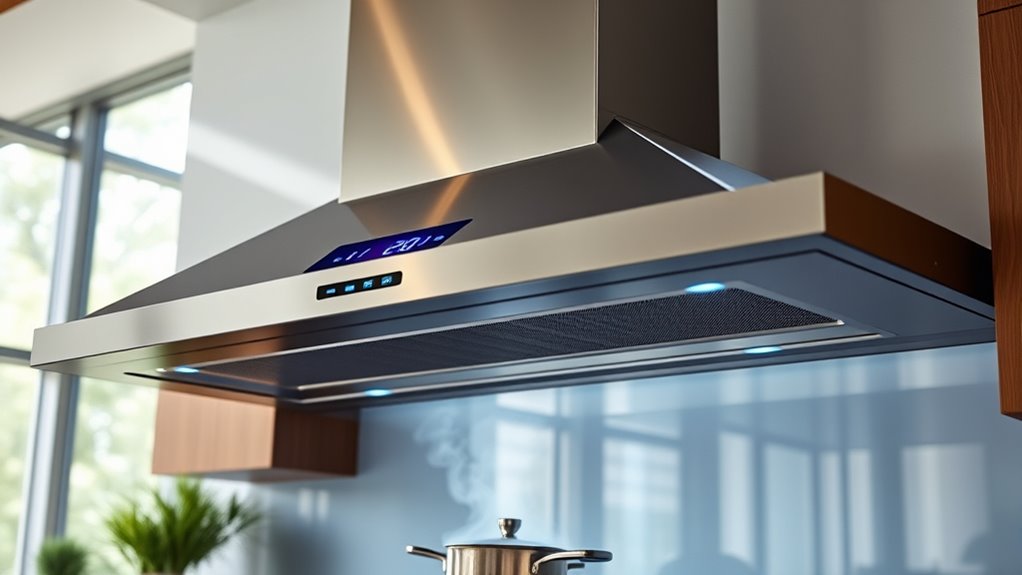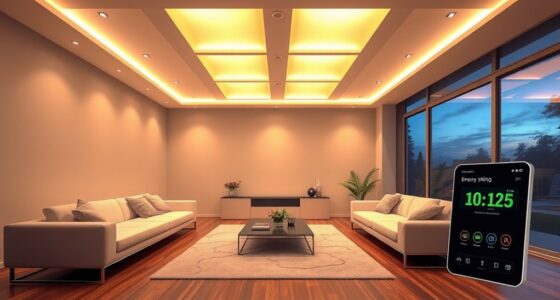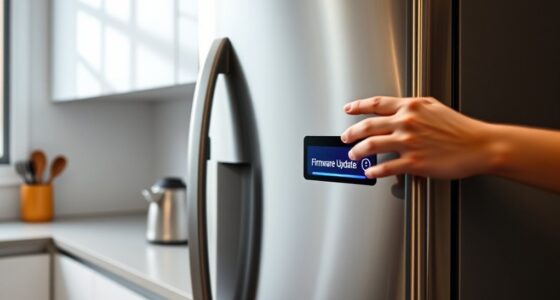Automating ventilation with air quality sensors and range hoods helps you improve indoor air quality and save energy. Sensors detect pollutants like CO2, VOCs, and dust, then automatically adjust airflow or activate fans and hoods to remove contaminants. This real-time response keeps your environment healthier and compliant with standards. Advanced controls and protocols make system integration seamless. Keep exploring to discover how these smart systems can transform your indoor spaces effortlessly.
Key Takeaways
- Air quality sensors detect pollutants like CO2, VOCs, and particulates to trigger automated ventilation adjustments.
- Range hoods equipped with IR controls and smart plugs enable dynamic fan operation based on sensor data.
- Communication protocols like BACnet and Zigbee facilitate seamless integration of sensors and ventilation systems.
- Automated systems optimize airflow in real-time, improving indoor air quality, energy efficiency, and occupant comfort.
- Regular calibration and maintenance of sensors ensure accurate detection and reliable ventilation control.
The Role of Air Quality Sensors in Modern Ventilation Systems
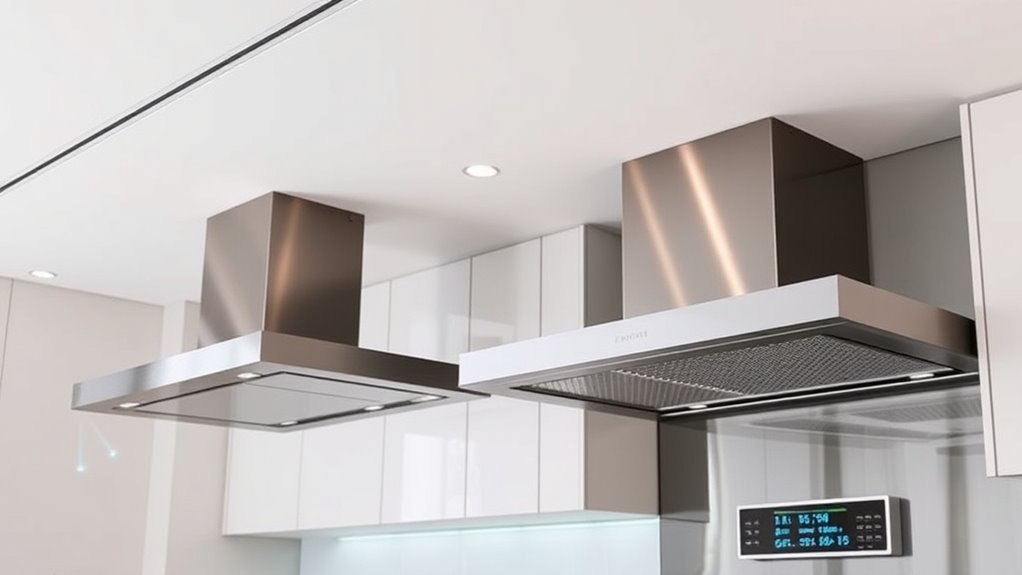
Air quality sensors play a crucial role in modern ventilation systems by providing real-time data on indoor air conditions. They constantly monitor pollutants like CO2, humidity, and VOCs, giving you immediate insights into your environment. When sensors detect elevated levels, they trigger automated adjustments in airflow, guaranteeing ideal air quality without your manual input. This real-time monitoring helps prevent buildup of harmful pollutants and maintains a comfortable atmosphere. Integration with IoT technology allows seamless communication between sensors and ventilation systems, enabling swift responses. Additionally, sensors set thresholds to alert you when air quality exceeds safe limits, prompting quick action. This continuous feedback loop ensures your indoor space stays healthy, comfortable, and energy-efficient. The sensors’ ability to provide continuous data enhances the responsiveness and effectiveness of ventilation management, ensuring optimal indoor conditions at all times. Incorporating air quality sensors into ventilation systems can also contribute to energy savings by adjusting airflow based on actual needs, reducing unnecessary energy consumption. Moreover, the use of smart technology allows for more precise control and optimization of ventilation performance.
Key Pollutants Monitored and Their Effects on Indoor Environments

Monitoring key pollutants in your indoor environment helps guarantee healthier air quality and prevents potential health issues. Biological contaminants like dust mites, mold, pet dander, pollen, and fungal spores can trigger allergies, asthma, and respiratory infections. Combustion pollutants such as carbon monoxide, nitrogen dioxide, particles, acid aerosols, and wood smoke pose risks like dizziness, lung disease, and irritated mucous membranes. Chemical pollutants like VOCs, pesticides, formaldehyde, radon, and asbestos may cause irritation, long-term health problems, or cancer. Particulate matter, secondhand smoke, aerosols, dust, and smoke particles directly impact your respiratory health. Moisture-related pollutants like mold, dust mites, bacteria, and cockroaches flourish in humid environments, worsening allergies and infections. Cybersecurity vulnerabilities can also be exploited through poorly secured ventilation systems, emphasizing the importance of cybersecurity awareness in smart home environments.
How Range Hoods and Ventilation Fans Work With Sensor Data
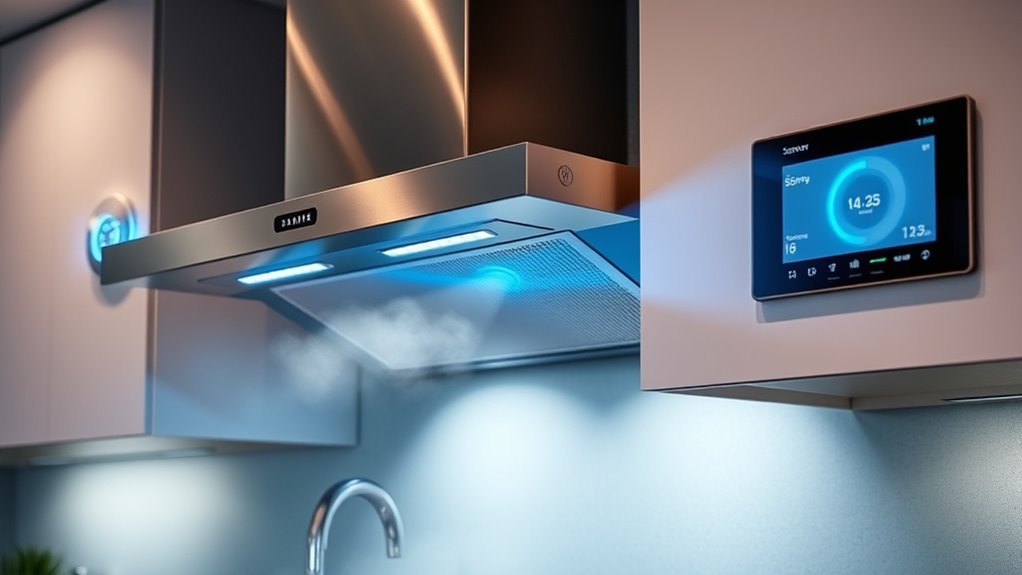
Range hoods and ventilation fans now leverage sensor data to automatically optimize indoor air quality and comfort. IR-controllable range hoods can be automated with IR transmitters that send fan speed and light commands, while energy-monitoring smart plugs infer fan speed based on power consumption. Scripts and template sensors centralize control logic and report fan states. Integrated air quality sensors in smart cooker hoods monitor pollutants like PM2.5, TVOCs, eCO2, humidity, and temperature, adjusting fan speeds dynamically to maintain freshness. Thermal sensors detect heat buildup, and pressure sensors ensure airflow efficiency. Gas sensors identify pollutants, prompting fans to activate or increase speed. Wireless protocols like MQTT and Zigbee enable seamless communication, allowing your ventilation system to respond automatically to real-time sensor data, ensuring a healthier, more comfortable indoor environment. Understanding store hours can help optimize shopping trips and ensure product availability when needed. Additionally, Kia Tuning techniques can optimize vehicle systems to improve performance and efficiency.
Technologies Enabling Automated and Responsive Ventilation Control
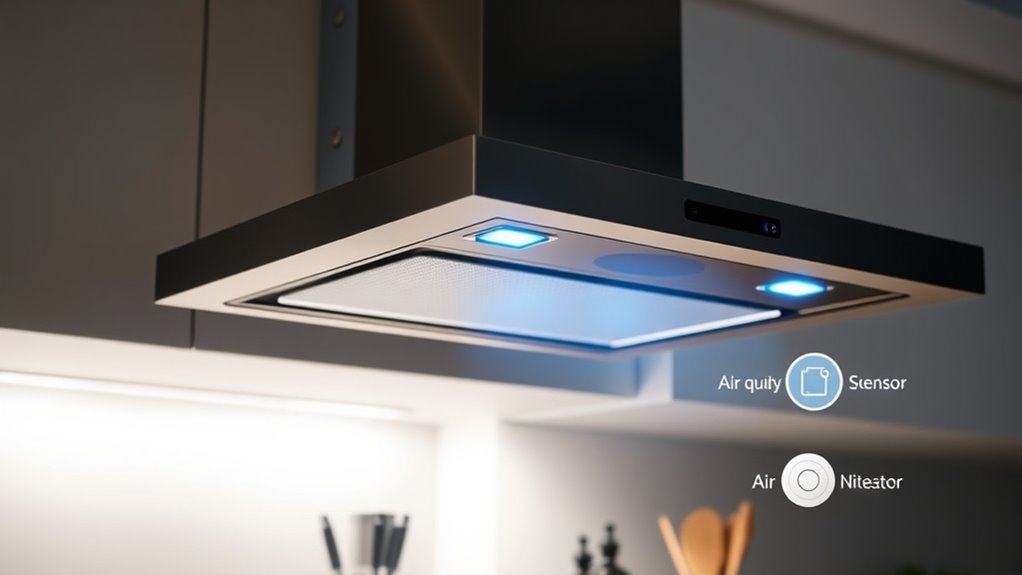
You’ll find that integrating multiple sensors like CO2, temperature, and precipitation allows your system to respond precisely to changing conditions. Automated control algorithms, including machine learning, predict environmental shifts to optimize airflow and energy use. Communication protocols such as BACnet and Modbus enable seamless integration with building management systems, making your ventilation truly responsive and efficient. Additionally, understanding high refresh rates in related display technology can inform the development of faster sensors and control responses, further enhancing system responsiveness. Incorporating AI-powered automation can further improve adaptability by learning from environmental patterns over time.
Sensor Integration Methods
Sensor integration methods form the backbone of automated and responsive ventilation systems by enabling real-time air quality assessment. You connect sensors measuring CO2, PM2.5, TVOC, HCHO, temperature, and humidity to building automation systems (BAS) via wired protocols like RS485 or wireless options such as WiFi. Open platforms like Home Assistant facilitate easy device discovery and configuration, streamlining deployment. Sensors are typically installed in localized spaces—walls or ceilings—near occupancy zones or pollutant sources to capture accurate data. Proper sensor placement ensures accurate data collection, which is essential for effective air quality management. This data feeds into BAS dashboards, allowing centralized monitoring and control across multiple zones. Communication setup supports automatic adjustments of ventilation, filtration, or window operation, while also enabling manual overrides through user interfaces or mobile apps. Precise sensor placement and reliable data handling assure effective, real-time indoor air quality management. Additionally, understanding the nutritional advantages of green juice can inspire healthier choices in indoor environments.
Automated Control Algorithms
Automated control algorithms are the core technologies that enable responsive and efficient ventilation management. Using machine learning, these algorithms analyze sensor data to predict occupancy and adjust ventilation accordingly, saving energy and improving air quality. They facilitate real-time modifications to temperature, airflow, and ventilation rates, ensuring ideal indoor conditions. Integration with IoT enhances communication between sensors, devices, and systems, allowing for seamless coordination. Predictive maintenance capabilities help identify system failures early, reducing operational costs. By continuously optimizing energy use—minimizing unnecessary heating, cooling, and ventilation—these algorithms contribute to sustainable building operation. They adapt to changing outdoor conditions and indoor demands, offering a smarter, more efficient approach to maintaining healthy indoor air quality. Understanding personality traits can also aid in designing more user-centric control systems that cater to diverse occupant preferences. Incorporating sensor data analytics further refines the responsiveness of these systems, enabling more precise environmental adjustments based on occupant behavior and preferences.
Communication Protocols Used
Communication protocols serve as the backbone that connects sensors, controllers, and actuators within ventilation systems, enabling real-time data exchange and coordinated responses. You’ll find BACnet, Modbus, and LonTalk as the most common protocols, supporting flexible and interoperable networks. BACnet offers both RS485 and Ethernet options, making it adaptable across systems. Modbus is simple and robust, ideal for device monitoring and industrial IoT applications. LonTalk, a proprietary protocol, is popular in building automation for HVAC tasks. Open protocols like BACnet and Modbus promote multi-vendor integration, allowing centralized dashboards to monitor air quality sensors and control ventilation accordingly. Wired connections such as RS485 and Ethernet ensure reliable communication, while wireless options are emerging for greater flexibility in modern smart buildings. Incorporating interoperability standards ensures seamless integration across diverse devices and manufacturers. Additionally, the development of standardized data formats enhances compatibility and simplifies system upgrades.
Factors to Consider When Implementing Sensor-Driven Ventilation Solutions
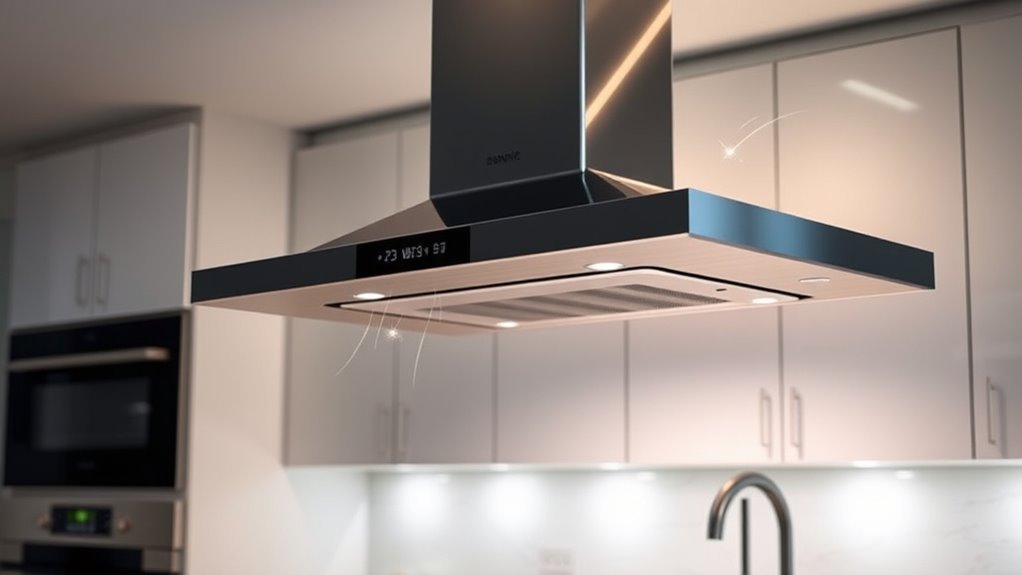
Implementing sensor-driven ventilation solutions requires careful attention to several critical factors to guarantee system effectiveness and reliability. First, sensor accuracy and calibration are essential; precise sensors ensure proper ventilation control, while regular recalibration prevents drift and false readings. Choose sensors that can distinguish relevant pollutants like CO2, VOCs, and particulates, and opt for low response times to enable real-time adjustments. Compatibility with existing HVAC and range hood systems is crucial for seamless integration; wireless networks should be interference-resistant. Sensors near range hoods must withstand high humidity and heat. Additionally, consider occupant engagement—clear feedback and training help optimize system response. Properly configured air quality sensors are vital for accurate monitoring and control. Finally, account for environmental factors such as outdoor conditions and occupancy patterns to prevent inefficiencies and maintain indoor air quality effectively. Proper maintenance, including regular cleaning and filter replacement, is vital to sustain sensor accuracy and overall system performance to ensure consistent operation.
Benefits of Automating Ventilation for Health, Energy, and Compliance
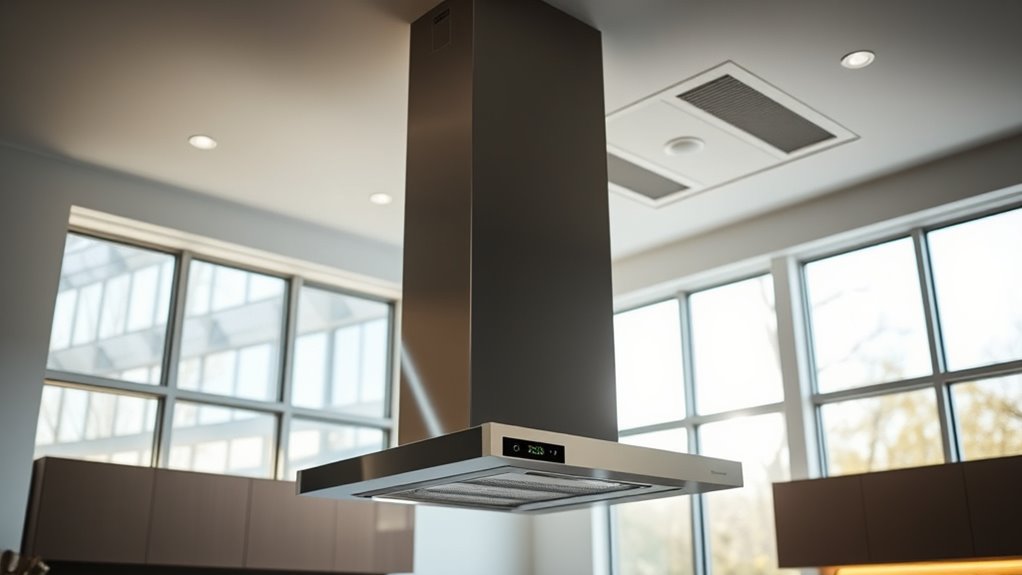
By continuously monitoring air quality and adjusting airflow accordingly, automated ventilation systems substantially improve indoor health and safety. They reduce your exposure to harmful pollutants like VOCs, carbon dioxide, and particulates, lowering symptoms of sick building syndrome. Automated systems also optimize lung protection by better controlling ventilation parameters, which can decrease respiratory distress and hypoxemia. Energy efficiency benefits are significant; dynamic airflow adjustments prevent over-ventilation, cutting HVAC energy costs, while sensor-activated range hoods only run when needed, saving power. Furthermore, automation ensures compliance with strict indoor air quality standards by maintaining pollutant levels within regulatory limits. Proper ventilation controls help in managing indoor air quality effectively. Real-time data logging and rapid responses to noncompliance help meet building and health regulations, providing peace of mind and supporting healthier, more efficient environments.
Future Trends in Smart Ventilation and Indoor Air Quality Management

Advances in smart ventilation technology are shaping the future of indoor air quality management. You’ll see IoT sensors monitoring air quality in real-time, allowing systems to automatically adjust airflow based on CO2 levels, humidity, and particles. AI integration will make HVAC systems smarter, optimizing settings for routine patterns and weather conditions. Energy-efficient dual-flow mechanical systems will become more common, recovering heat while ensuring fresh air intake. The market is expanding rapidly, with a projected 35% growth by 2025, making advanced filtration and eco-friendly materials more accessible. Expect remote control via smart home apps, predictive maintenance alerts, and aesthetically pleasing designs that blend functionality with style. These innovations will create healthier, more sustainable indoor environments with less effort on your part. Vibe coding techniques will further enhance system responsiveness by enabling more intuitive control based on user preferences and environmental cues. Additionally, ongoing research into air quality monitoring will continue to improve sensor accuracy and reliability, supporting smarter ventilation solutions.
Frequently Asked Questions
How Do Air Quality Sensors Maintain Accuracy Over Time?
You maintain air quality sensor accuracy over time through regular cleaning, inspections, and timely part replacements to prevent dust and debris buildup. Calibration is vital; you should do it consistently under controlled conditions using reliable standards. Environmental factors like humidity and temperature affect readings, so applying correction models helps. Monitoring data across a sensor network and using fault detection tools ensures early issue identification, keeping your measurements precise and reliable long-term.
Can Sensor-Based Ventilation Systems Operate During Power Outages?
During a power outage, sensor-based ventilation systems typically stop working because they rely on electricity. Imagine the building’s breath slowing, with stale air lingering as the sensors fall silent. To keep air flowing, you can use options like manual range hoods, natural ventilation, or backup batteries. These alternatives help maintain some level of fresh air, but they don’t match the precision of fully automated, sensor-controlled systems during normal operation.
What Are the Cost Implications of Installing Automated Ventilation?
Installing automated ventilation increases your upfront costs due to advanced hardware, sensors, and sophisticated controls. Expect higher installation fees because specialized contractors often handle programming and calibration. However, these systems can lower your long-term energy bills by optimizing airflow based on real-time air quality, saving you money over time. Keep in mind, maintenance costs may rise, but the improved indoor air quality and energy efficiency can be well worth the investment.
How Do Sensors Differentiate Between Indoor and Outdoor Pollutant Sources?
Think of sensors as detectives piecing together clues. They differentiate indoor and outdoor pollutants by analyzing patterns—indoor spikes during activities like cooking signal internal sources, while steady outdoor levels relate to weather or traffic. Placement at breathing height and cross-referencing data from indoor and outdoor sensors help identify pollutant origins. Advanced algorithms and environmental data further sharpen this detective work, ensuring your ventilation system responds only when truly needed.
Are There Privacy Concerns With Continuous Indoor Air Monitoring?
Yes, there are privacy concerns with continuous indoor air monitoring. You might unknowingly gather sensitive data about occupants’ behaviors, habits, or presence, which can be misused if not properly secured. Without proper encryption or anonymization, this data could be accessed by unauthorized parties, risking privacy breaches. To protect yourself and others, make certain that data handling complies with privacy laws and that transparent policies are in place to minimize risks.
Conclusion
Just as Daedalus crafted wings to navigate new heights, embracing sensor-driven ventilation lets you elevate your indoor air quality effortlessly. By harnessing smart technology, you can create a healthier, more energy-efficient space that adapts to your needs—no more guessing or manual adjustments. As we step into this future, remember, it’s not just about breathing easier, but about mastering the air we share, turning your home into a sanctuary of clean, responsive comfort.
